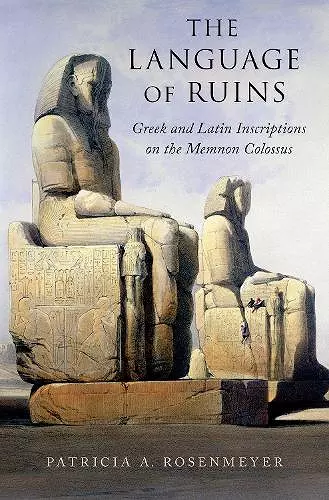The Language of Ruins
Greek and Latin Inscriptions on the Memnon Colossus
Format:Hardback
Publisher:Oxford University Press Inc
Published:10th May '18
Currently unavailable, currently targeted to be due back around 25th December 2025, but could change

A colossal statue, originally built to honor an ancient pharaoh, still stands today in Egyptian Thebes, with more than a hundred Greek and Latin inscriptions covering its lower surfaces. Partially damaged by an earthquake, and later re-identified as the Homeric hero Memnon, it was believed to "speak" regularly at daybreak. By the middle of the first century CE, tourists flocked to the colossus of Memnon to hear the miraculous sound, and left behind their marks of devotion (proskynemata): brief acknowledgments of having heard Memnon's cry; longer lists by Roman administrators; and more elaborate elegiac verses by both amateur and professional poets. The inscribed names left behind reveal the presence of emperors and soldiers, provincial governors and businessmen, elite women and military wives, and families with children. While recent studies of imperial literature acknowledge the colossus, few address the inscriptions themselves. This book is the first critical assessment of all the inscriptions considered in their social, cultural, and historical context. The Memnon colossus functioned as a powerful site of engagement with the Greek past, and appealed to a broad segment of society. The inscriptions shed light on contemporary attitudes toward sacred tourism, the role of Egypt in the Greco-Roman imagination, and the cultural legacy of Homeric epic. Memnon is a ghost from the Homeric past anchored in the Egyptian present, and visitors yearned for a "close encounter" that would connect them with that distant past. The inscriptions thus idealize Greece by echoing archaic literature in their verses at the same time as they reflect their own historical horizon. These and other subjects are expertly explored in the book, including a fascinating chapter on the colossus's post-classical life when the statue finds new worshippers among Romantic artists and poets in nineteenth-century Europe.
The Language of Ruins' will, I suspect, be the definitive account of the Memnon inscriptions for many years to come. * Robert Cioffi, Gnomon *
[a] rich and rewarding book. The Language of Ruins will be of interest to classicists studying topics as diverse as Roman antiquarianism, ancient pilgrimage and elite tourism, and the reception of Homer and Sappho in the first few centuries AD. The book also has much to offer those working on Egyptomania, the cross-cultural understanding of ruins, and the entanglement of vernacular and learned as well as ancient and modern discourses about antiquities ... Rosenmeyer should be commended for breathing life into all the Greek and Latin inscriptions on the colossus. * Felipe Rojas, Bryn Mawr Classical Review *
A very readable account of a well-researched but relatively little-known subject area... This book is to be very highly recommended, blending as it does the Egyptian, Greek and Roman religious ideas and experiences. * Campbell Price, Ancient Egypt Magazine *
In this brilliant study, one of antiquity's most exciting collections of inscriptions finally receives the thoughtful, comprehensive analysis it deserves, complete with a full text and translation. Patricia Rosenmeyer brings her deep knowledge of Greek literature to bear on the religious, poetic, and historical dimensions of the Memnon corpus, paying special attention to the role of women as authors and pilgrims, and to post-classical receptions of the monument. An invaluable contribution to the history of cultural exchange during the Roman Empire. * Verity Platt, Cornell University *
Patricia Rosenmeyer's reading of the sources addresses issues that range from sacred tourism in the Roman Empire and the motives, status, and cultural conditioning of the Greek and Roman visitors to the site to the poetics of inscription, relations between the fragmentary and the colossal, and the erasure of Egypt in the extant sources. The final chapter updates this fascinating story, treating the rediscovery of the image by travelers of the eighteenth and nineteenth centuries and the place it claimed in the European imaginary. * Deborah Steiner, Columbia University *
The statue of Memnon in Egypt, whose voice, it is said, was heard at sunrise from its absent head, was a popular tourist site under the Empire, and an irresistible opportunity for inscription, ranging from graffiti to literary composition. Rosenmeyer, with charm and skill, follows the many traces of this uncanny story, from ancient to modern times. * Froma Zeitlin, Princeton University *
ISBN: 9780190626310
Dimensions: 236mm x 155mm x 25mm
Weight: 748g
296 pages